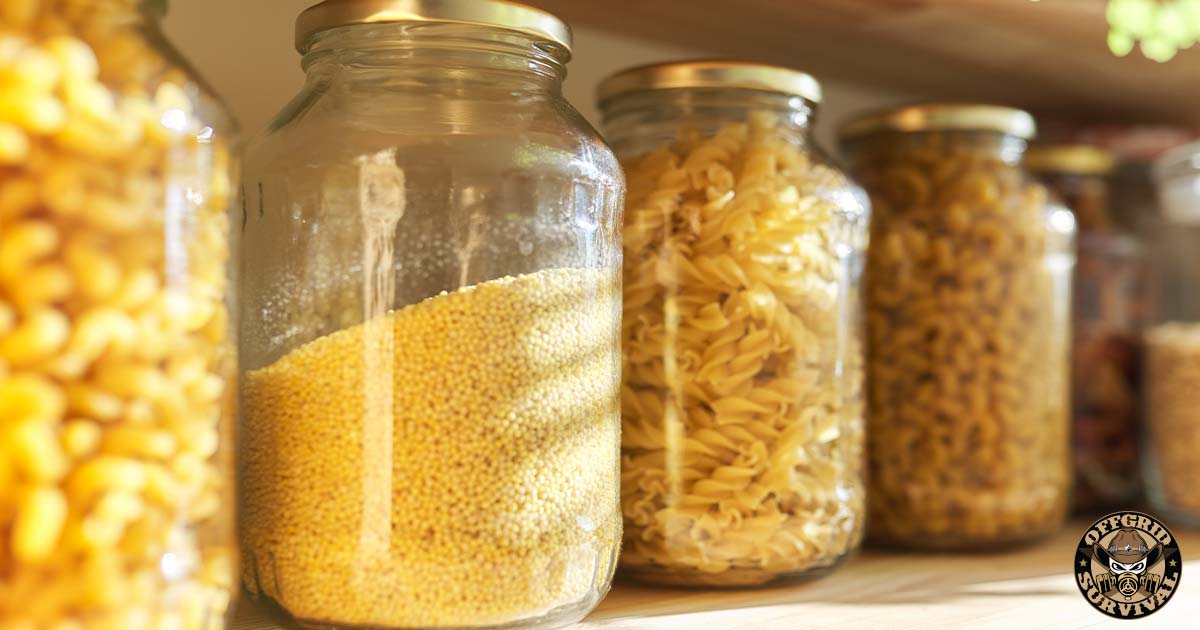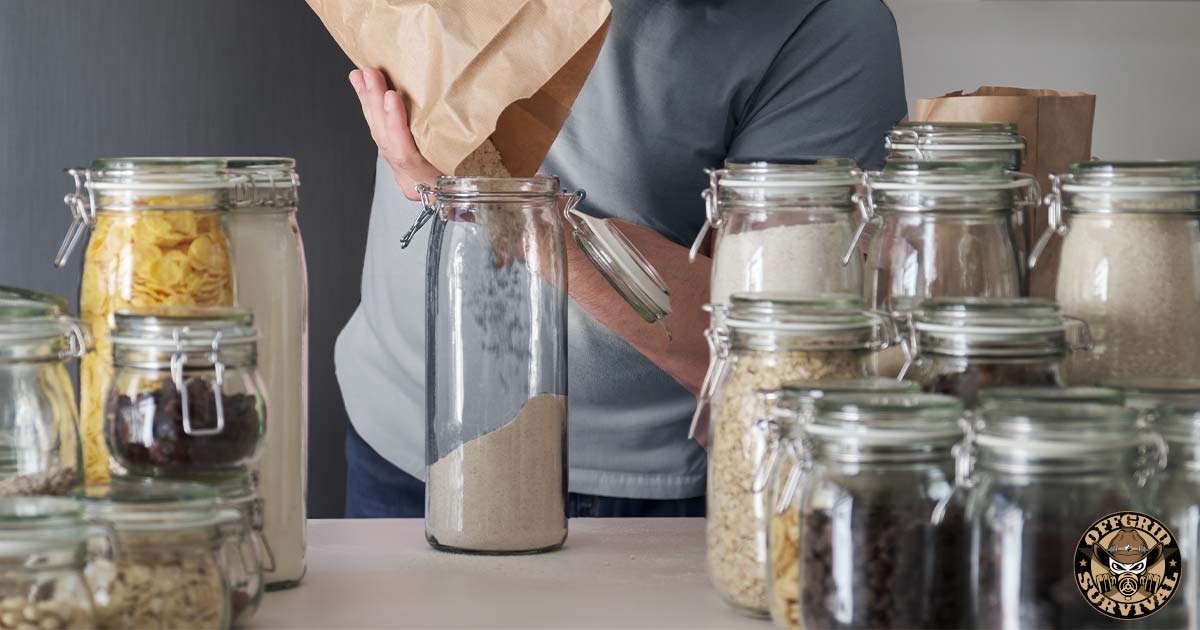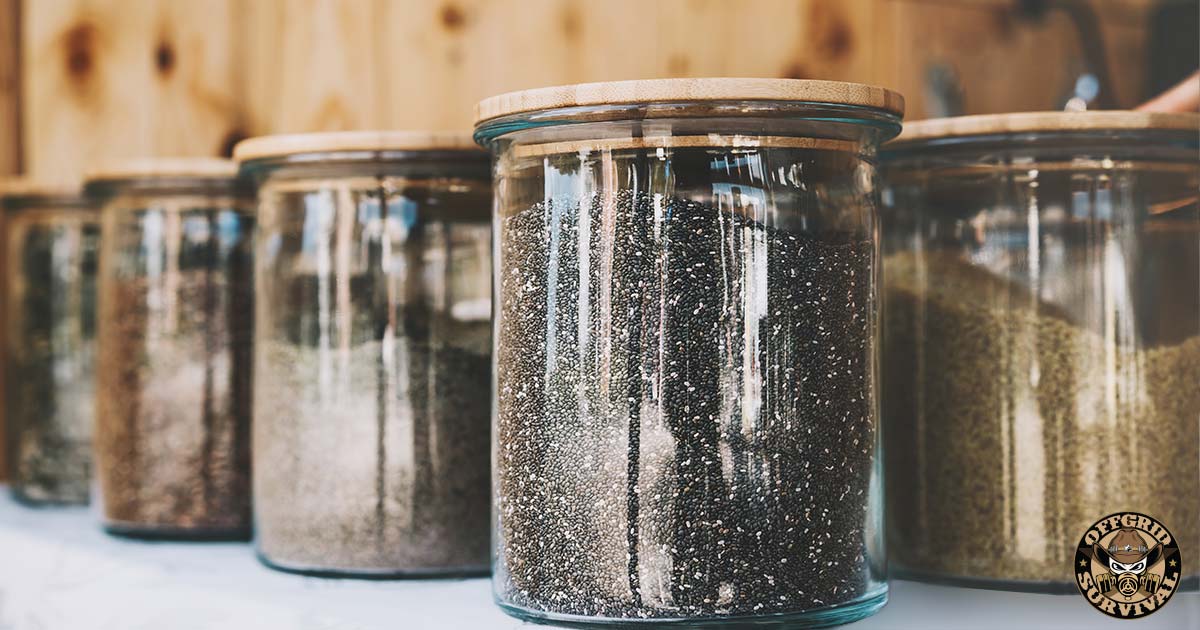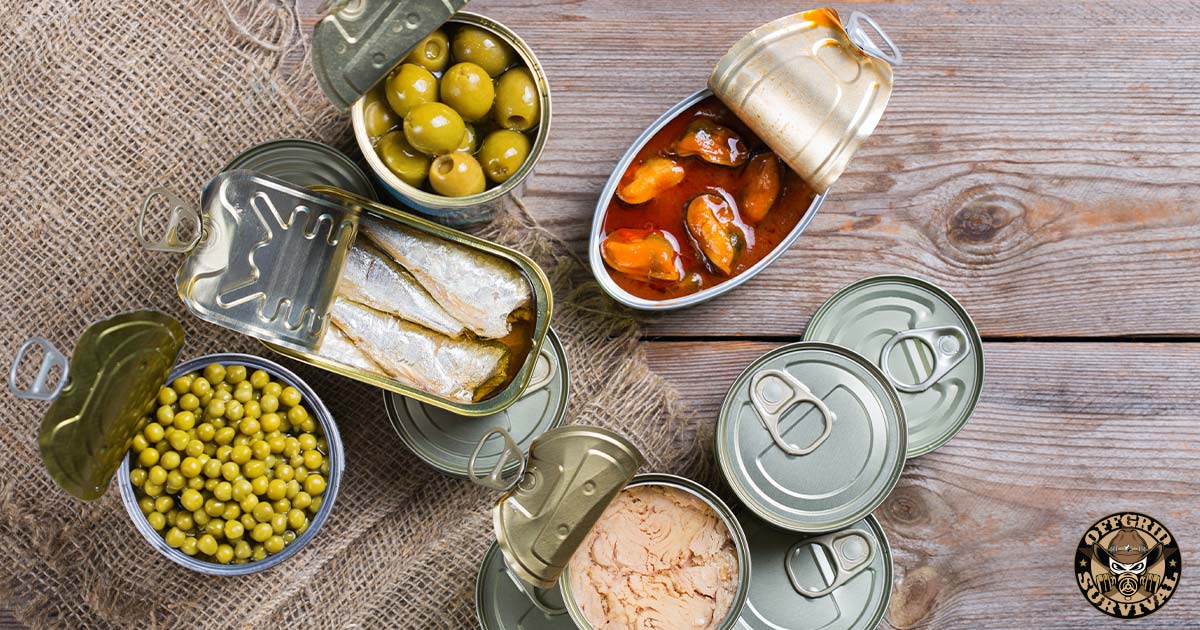
When disaster strikes, there’s a pretty good chance your local grocery stores will be stripped bare in a matter of hours. From panicked people trying to stock up on last-minute supplies to those who failed to prepare for even short-term disasters and now find themselves facing the prospect of starving, your local grocery store will look like a battleground in a post-apocalyptic movie.
Most grocery stores have a maximum three-day supply of goods on hand before they run dry. That means even short-term disasters like hurricanes, floods, and earthquakes can cause supply chain problems that will quickly wipe out their inventory. Now throw in a long-term disaster that cuts off supplies for months, and you have a real recipe for disaster.
To be prepared to face an emergency situation where supply chains fail and food deliveries are blocked, you need to invest in a long-term food supply. This supply should be made up of at least six months’ worth of emergency food with a long shelf-life – preferably something that you already eat.
From Supermarket Shelves to Survival Pantry: Building Your Emergency Food Stockpile with Long-Lasting Food From The Grocery Store

In the face of so many uncertainties, it’s important to ensure you and your loved ones’ survival by stocking an emergency pantry with long-lasting food supplies. While many so-called survival experts try selling commercial ‘survival food’ as the answer, we advocate for building your stockpile with familiar foods you probably already eat – all from your local grocery store or farmer’s markets.
During an emergency situation, the last thing you want to do is eat a bunch of weird survival foods that you’ve never eaten before – from possible allergy concerns to the stuff just downright tasting like crap, now is not the time to start experimenting. On top of that, we don’t like wasting money, so buying foods you already eat and running them on a rotation system that ensures you don’t find yourself years from now with a pantry full of expired food!
With the help of suggestions that have come in from our readers, we have compiled a list of the top food items and emergency supplies that you can buy at the grocery store. The list contains foods with a long shelf-life, items that have multiple uses, and supplies that are great for bartering.
Survival Foods that add flavor & comfort:
Comfort foods can be a huge morale booster during a stressful survival situation, something that needs to be kept in mind when starting to stockpile food. These four things can be stored for over 10 years, and are a great way to add a little bit of flavor to your cooking. If stored properly they will probably last indefinitely.
- Salt: From food preservation to maintaining proper electrolyte balance in the body to enhancing the flavor of your food, salt is an an essential part of your food storage stockpile!
- Sugar: – Brown or White sugars can be stored for quite some time and during emergencies or high-stress situations can help boost energy levels and provide a quick source of fuel. It can also be a huge morale booster when things start getting tough.
- Raw Honey: Honey has an incredibly long shelf life contains numerous vitamins, minerals, and antioxidants. Honey has also been used for centuries as a natural remedy for wound healing due to its antimicrobial properties.
- Alcohol – Whiskey, Vodka, etc.: From bartering to health and medicinal uses, alcohol is one of those items that should be part of any good preparedness stockpile. Check out our article on which liquors are best to stockpile for preparedness.
Base cooking ingredients with a long shelf life

Many people today lack the ability to cook anything from scratch, relying heavily on prepackaged and processed foods. This trend is unhealthy, but it could prove deadly during a long-term survival situation. Learning how to cook from basic ingredients is crucial for successfully preparing for emergencies and ensuring self-sufficiency in food storage.
The following categories of food make up the foundation of most recipes and are all things that store well.
Hard Grains: Stored properly hard grains have a shelf life of around 10 – 12 years.
- Buckwheat
- Dry Corn
- Kamut
- Hard Red Wheat
- Soft White Wheat
- Millet
- Durum wheat
- Spelt
Soft grains: These soft grains will last around 8 years at 70 degrees, sealed without oxygen.
- Barley,
- Oat Groats,
- Quinoa
- Rye
Beans: Sealed and kept away from oxygen the following beans can last for around 8 – 10 years.
- Pinto Beans
- Kidney Beans
- Lentils
- Lima Beans
- Adzuki Beans
- Garbanzo Beans
- Mung Beans
- Black Turtle Beans
- Blackeye Beans
Flours and Mixes and Pastas: 5 – 8 years
- All Purpose Flour
- White Flour
- Whole Wheat Flour
- Cornmeal
- Pasta
- White Rice ( up to 10 years)
Oils: It’s important to include fats in your stockpile. Fats are a concentrated source of energy and are crucial for overall health and well-being.
- Coconut oil – Unrefined, virgin coconut oil has one of the longest shelf lives of any kind of oil. It can last for over 2 years, has numerous health benefits, and is a great item to add to your survival food supply list.
- Clarified butter (Ghee): Clarified butter, also known as ghee, is butter that has been heated to remove moisture and milk solids. The process increases the fats stability and extends its shelf life. Ghee can last for several months to a year when stored in an airtight container in a cool, dark place.
- Olive oil: Extra virgin olive oil has a decent shelf life and can be stored for up to a year or more if kept in a cool, dark location.
For more information on cooking from scratch, check out these articles and books:
- Important Homesteading Preparedness Skills: Learn how to cook from scratch
- Best War Time Recipes: A Look at Preparedness Cooking Skills from the Past
- Fanny Farmer Cookbook
- Better Homes and Gardens Cookbook
- The Pioneer Woman’s Cookbooks
What About Buying Canned Goods for your Survival Pantry?
Proper Storage and Shelf Life of Canned Goods
We get a lot of questions on canned goods and how long they can safely be stored. To ensure the quality and safety of canned goods, it’s important to store them correctly and be aware of how long the manufacturer recommends they be stored. And remember, most best-by dates are placed there to protect the manufacturer from lawsuits, The U.S. Department of Agriculture says that most shelf-stable foods are safe indefinitely. In fact, they say canned goods will last for years and that dating is for quality, not safety.
Here are some guidelines to follow when dealing with store-bought canned goods and most shelf-stable foods:
1. Storage: Keep commercially canned foods and other shelf-stable products in a cool, dry location. Avoid placing them above the stove, under the sink, or in areas prone to high humidity or temperature fluctuations, such as a damp garage or basement.
2. Shelf life: The shelf life of canned goods varies depending on the type of food. High-acid foods like tomatoes and fruits maintain their best quality for up to 18 months, while low-acid foods such as meat and vegetables can maintain their original quality for 2 to 5 years. But again, if cans are undamaged (no dents, swelling, or rust) and have been stored properly in a cool, clean, dry environment, they can remain safe indefinitely.
3. Safety precautions: While extremely rare, the production of toxins by Clostridium botulinum bacteria poses the most significant risk when dealing with canned goods. To minimize the risk, make sure your cans are in good condition and show no signs of damage or contamination. If any cans appear compromised (bulges or leaks), it’s best to get rid of them to avoid any potential health hazards.
For more information on canning your own foods at home, check out our article on Canning your own food!
Survival Foods that are great during short-term disasters

The following items are great for short-term emergencies, and will stay fresh for a long period of time. During most disasters, you’re going to want to have food that requires very little cooking, or can be eaten without any preparation at all. Make sure some of your stockpile includes these types of food.
Other good survival foods: 2 – 5 years of shelf life
- Canned Fish: Tuna, Salmon, Sardines
- Canned Meats: Chicken, Beef, Pork, Spam & Sausages
- Canned Vegetables & Fruits
- Peanut Butter
- Coffee
- Tea
- Ramen Noodles – not the greatest food in the world but they are very cheap so they made the survival food list.
- Hard Candy
- Powdered milk
- Dried herbs and spices
- Canned soups (a variety of flavors)
- Canned pasta sauces
- Canned broth or stock (chicken, beef, or vegetable)
- Crackers or rice cakes
- Dried fruits (raisins, apricots, cranberries)
- Nuts (almonds, walnuts, peanuts)
- Granola bars or energy bars
- Cereal or granola
Items that can be used for more than cooking:
- Apple Cider Vinegar – Cleaning, cooking and has antibiotic properties
- Baking Soda – Cleaning, cooking, etc…
- Honey – Mentioned again for its antibiotic properties and wound healing.
Nonfood items to stock up on at the grocery store:
- Bic Lighters
- Toilet Paper
- Soaps
- Bottled Water
- Multi-vitamins or supplements
- Medicines
- Bandages
- Peroxide
- Lighter fluid
- Canning Supplies
- Charcoal
More Emergency Food Resources
While we always advise the DIY approach to stockpiling food, this way you have the things that you would normally cook and eat and can then rotate them in and out of your normal life, there are some circumstances where commercially made survival food supplies might make sense. Here are some of the top emergency survival foods that can help you quickly bulk up your emergency supplies.




You should only buy things that you would normally eat. It’s hard enough dealing with the stress of survival and have to eat something that you might not like.
I/m 71 and have raised my kids on how to survive. My youngest grandson stayed with me for 4 years. As soon as he could go for a walk in the woods we played I spy! “I spy a red mushroom and on and on to leaves and bark. Whats edible, how to forage. My dtrs all keep 6 to 12 mo food supp;y. They have chickens, Can their food and have emergency routes all planned ahead. I live in the mountains of VA and my grandson was brought to see me. He jumped out of the van started naming all the plants and then jumped up and down when he spotted the fig tree(he loves figs, 1 for the bag and 1 for me! that is his motto My dtr (the biologist) called him over and demanded how he knew all that ! He said “just look at the leaves mom! its easy. Made my month ,lol .My point is do what you can to teach your kids, how to garden, how to can the food, How and when to hide how to make simple snares and traps. Not all grandmas sit and knit! Tho I do that also. Its OK Frank, your grandma will happily pass on some of her knowledge. Hope she is there for you ; )
I LOVE YOU JoAnne Breaux !!!!!
I consider myself to be one of the lucky ones. My parents were raised on the farm during the depression. All they had was food on the table, a roof over their heads and lots of hard work on the farm. You talk about a wealth of knowlege on survival. I was raised in the city, but my parents taught all of us kids the importance of making do with what you had. My papa has since past, but mom is still kicking at 84. I can garden, preserve meat, hunt, fish, home can, build things, fabricate tools and make my own soap. Times will be especially hard on older folks and children, but my family honors our elders with respect and pride for what they have accomplished. My wife and I come from rather large and diverse families. My thought on survival during difficult times is to keep the family network tight and if you have no family to depend on, form a group of close friends and neighbors for support. This way, even if you are unable to secure necessary survival items in your stash, as a collective group, your chances are much better. Yes, I know there are some people that will try and do terrible things during stressful situations, but I still believe there are good people out there whose moral values will still be retained. All I can say to you “takers” out there is don’t show up at our doorstep because you will get more than you bargained for.
hey , I just browsed some of your posts so I do not know if this was mentioned or not. High carb / fiber is a given for any long term survival list . Keep in mind that many of these foods can be constipating especially if you don’t have fresh fruits and veggies to keep you regular …. constipation can not only be uncomfortable but life threatening if it goes on long enough. Having said that , several bags of Epson salt can be a life saver . It not only works for moving your intestinal track along but good for sprains and fantastic for your garden . I recommend glycerine suppositories for children.
just me 2 cents
peace , Donna
Enjoyable convo all around. Young and Old. I am one year and two months serving in the Peace Corps in Africa. One year left at age 25. I must say all foods above are in my pantry. No running water or electricity. Problems faced include threat of malaria, giardia, hiv, lack of clean water, 120° heat, spiders snakes rabid dogs scorpians crocs and hippos. I must say the big problem is food security. Any pointers on another meal to add to diet that can be bought at the grocery chain store in city to enhance my diet? Thanks Bobby
These are great tips!! I’m slowly building my store stock supplies but decided to start growing edible multi use plants as well. Aloe of course , fruit trees but my favorite is the Moringa tree. It grows very fast! You can do everything from purifying dirty water to eating the leaves raw! Google it to see all the benefits:) If shtf just think how nice it would be to go pick some nutritional and protein packed leaves off your tree for dinner if someone stole your can goods.
Wow.. of all this, I can’t believe the Frank guy got over 2 years of replies.
We have been prepping for nearly two years. We have found some awesome tight sealing containers with screw on tops at the dollar store. They come in several different sizes. Most pastas and rice come in cardboard boxes, which are not water proof. We put all of our pasta and rice into the containers, so not only are they sealed from air, but also water. We have also been stocking up on medical supplies, toiletries, and paper products. Prepping is the cheapest thing in the world, but even $10 a week can go a long way, especially if you know what you need to stock pile. Peace to all and happy prepping :)
christine, I do the same thing. I put rice or pasta in canning jars, I put the jars in a plastic bucket with sealable lid and place them in my craw space under the house. However I do add a teaspoon (pint) or tablespoon (quart) of 100 per cent FOOD GRADE diatomaceous earth to the food, seal and gently shake. The food grade diatomaceous earth is edible and will kill any tiny bugs that may develop in the food.
I think it will last a lot longer this way
Oh, and one other thing…flours and sugars seal up nicely in these containers as well. We are actually considering storing matches, string, and other non-water loving items in them too. Carry on…
In addition to the basic food stuff, flour, honey, rice, beans, ect. I strongly urge you to add canned powdered eggs to your survival lists, and some form of cake mix or some treat to combat the “privation depression” most will suffer from due to the psych. impact of survival after an event.
My suggestion for serious minded people who want to survive is simply this….KEEP YOUR POWDER DRY…those
that haven’t planned for any disaster will be coming for those who thought ahead. Hunger does strange things to people and protecting what’s yours is an important part of staying alive.
Great info, but has me thinking why? have eaten a tin of tuna 12 years old no problem four tins in all plus a two tins of corn-beef twenty years old no problem perhaps the dates on the can’s can be extended.
REGARDS
G DAVIES.
Im 32 grew up in southern Arkansas fishing and hunting and survival was a way of life. I like to think people who grow up the way I have do have a slighter upper hand in survival senarios but the truth of the matter is that none of us truley knows what the senerio will be. When you think of the scope of things now there is everything from nuclear, bio, financial or social unrest. A million scenarios for a million situations. That having been said I stay to primary servival items that work for any situation. 1. Food, 2. Water, 3. Mobile shelter, 4. extra clothing, 5. Ability to make fire, 6. Knowledge of natural medical info (plants ext., 7. First aid kit. There are other things but those aside from a route plane and Point of meet up are primary for servival. Don’t forget items for water purification and a form ofdefence.
Antibiotics if you can get a hold of them also but that at least where I am is hard to do.
Who would you save?? A loud mouth young punk that knows it all or someone in there 60s, 70s or 80s??? Sorry punk, your dead!!
Thanks to all for the great advice.
I’m a 55 year old divorced woman living on a modest income. Here’s something I did a while back that really helped with the prepping.
I made the decision to turn off the power for 24 hours (no cheating). It went a long way in figuring out what I really needed to be self-sufficient. I added things to my list as the day went by.
Simple things like using a clothes line, finding alternate ways to cook food. There is water in your hot water tank enough to keep you alive for a few days at least.
I re-organized the household more efficiently. Found an old a wind-up clock in the attic. Tools I would need. Solar garden lights to brighten up the evening hours.
Found a decent wood stove at an auction, keeps the house warm when the power goes off and it’s great to cook with as well.
It’s truly amazing the stuff we all take for granted! After the 24 hours had gone by, I had my list of essentials.
I’ve also done some renovations to make the house more secure.
Herbs and spices can easily grow on a window sill. Start gardening now, don’t wait until your in ‘panic-mode’ to learn the skills you will need. Even a small patio can hold a few containers of tomatoes.
Eggs can keep for at least 6 months if you coat them with mineral oil.
Bottom line is this – don’t wait for the stuff to hit the fan, you’ll be too upset to think straight.
Look around your house/apartment and figure out what your needs really are.
All the best,
I would add, besides alcohol (for multiple purposes) tobacco for trade. Specifically rolling papers & loose tobacco (cheaper & easier to store). Have you ever seen someone “jonsing” for a puff?
You guys argue over the stupidest shit.
Mrs. Hall- water and whatever canned good last the longest. Follow the list from above. Oh and get a water purifier too.
Frank: we all agree you are an arseholio.
The 64 year old: computers came out in the 1980’s. Where were you? On vacation apparently.
The rest of you stop arguing and start stocking damn it. Stock stock stock damn it. Stock til your little hearts can’t stock any more. Stock till the cows come home. Stock til the end of days. Stock STOCK STOCK you little warriors.
The information on flour storage concerns me. Morman storage ctrs, flour manufactures such as robin hood or king arthur and others set the maximum storage for white flours at 18 mths mac with or without vaccuum sealing or oxygen obsorber treatments. Also whole wheat flours have almost no long-term storage capacity. They turn rancid very fast. Many you find on grocery shelves are already rancid at purchase. I have ground whole wheat for 20 years and my experience is the same as the flour manufacturers. Just an FYI so people don’t waste money storaging flour long term.
Thanks for the list.
Makes me feel better about the choices I made a few years ago vacuum packing and storing emergency supplies, and gives me more ideas to supplement my stocks.
No mention of bleach for purification of water? You can drink practically any water by first purifying it with bleach 8-16 drops per gallon.